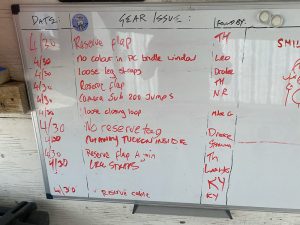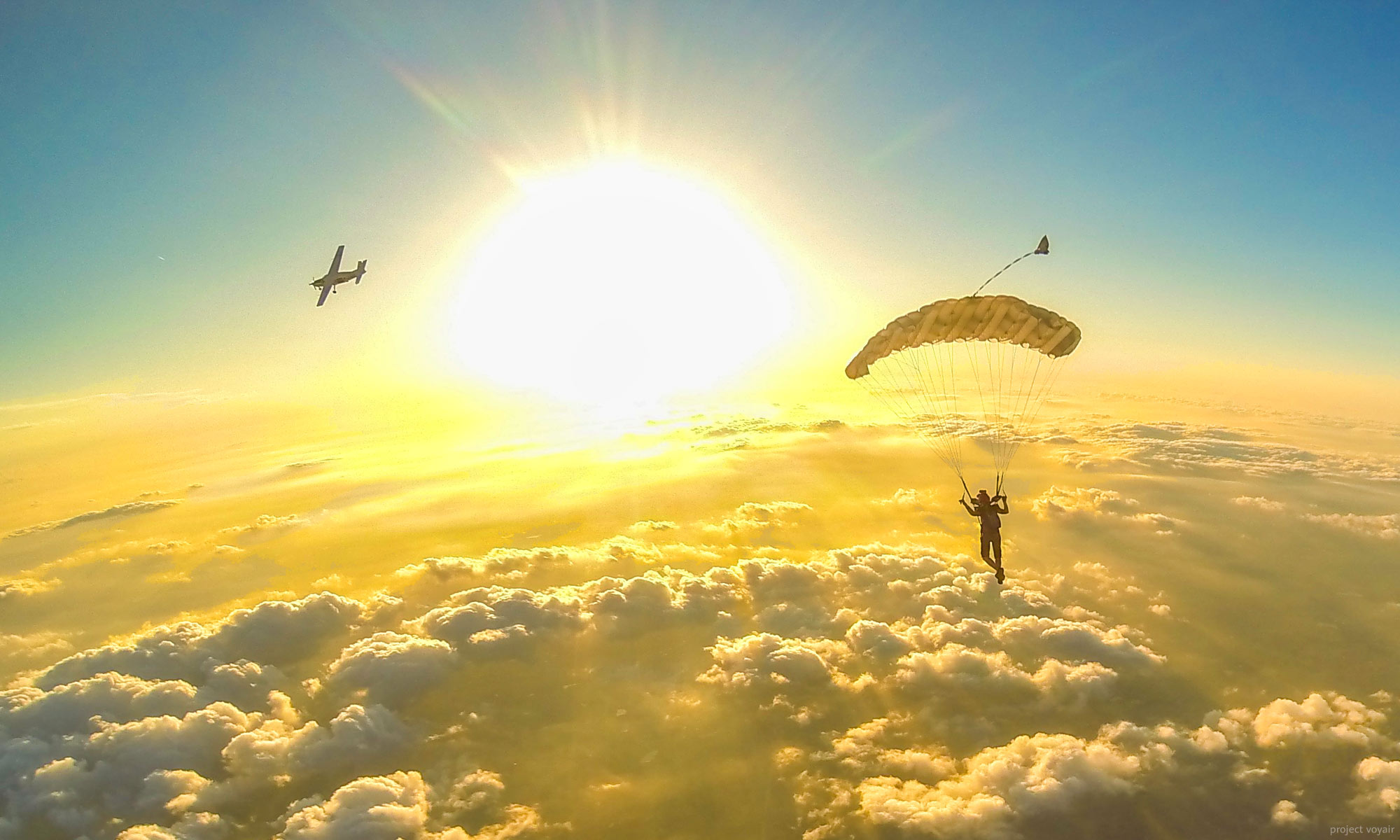Skydivers, I have great news and some bad news. Let’s start with the great news.
Great News: A lot of skydivers are doing a really great job of checking their friends’ gear in the loading area and helping them correct issues before getting on the airplane. Kudos, way to watch out for all of us!
Bad news: These highly vigilant humans are catching way too many gear problems on people who think they are ready to skydive.
Skydive Spaceland’s policy is that jumpers do not enter the loading area until they are geared up and ready to skydive. Even team jumpers doing back-to-back jumps are not exempt from this; they won’t be there on the 5-minute call, but they must still be fully geared up with all straps tightened and stowed when they arrive at the loading area. In other words, all gear problems should be caught before the jumper enters the boarding area.
For several months now, Skydive Spaceland San Marcos has had a dry erase board posted in the loading area for listing gear/safety problems found there, with a shoutout to the person who caught the issue. The person who catches the most often gets a free jump for being awesome.

On a single busy weekend day, the gear/safety board filled up with 11 issues found, from minor to potentially major. A couple of these may have been a choice made in ignorance of/resistance to the policy, such as two jumpers with loose leg straps. However, most were not in that category:
- Open reserve flap: 3 instances
- No color showing in collapsible pilot chute bridle window: 1 instance
- Trying to jump a camera with less than 200 jumps: 1 instance
- Dangerously loose closing loop: 1 instance
- No reserve tag (Spaceland also requires a reserve tag on the lateral to show when the reserve goes out of date, for loaders to check easily): 1 instance
- Cutaway handle tucked behind main lift web: 1 instance
- Reserve cable end/ball stuck in handle velcro: 1 instance
Each one of these jumpers thought they were ready to skydive. However, they obviously were not. Any of these issues would have been caught with a good self gear check (except perhaps the choice to fly a camera when not ready–that’s a whole different article).
“I can almost always find something of fault in the loading area on most loads,” says San Marcos operations manager Thomas Hughes.
We can do better.
For the sake of our own safety and that of others on the load with us, we MUST do better.
Gear problems that should have been caught tend to stem from four problems (sometimes in combination):
- No gear check (shame on you!). People will never admit to doing no gear check at all, but it absolutely happens. When you show up in the loading area with the rigger’s inspection report still sticking out of your reserve flap, for example, that’s a dead giveaway. (Pun most definitely intended.) We really shouldn’t have to say it, but every skydiver must do a gear check! Every jump!
- Poor/overly casual gear check. Occasionally a jumper doesn’t quite understand what they’re checking, especially if they are less experienced and/or jumping an unfamiliar rig. For example, maybe it has an RSL and they aren’t used to having one? Or the rig may have an alternate cutaway hardware system.
- A jumper could be lazy and only check the bare minimums rather than really looking at the condition of the gear (which may be important if they recently surfed in a landing and abraded a leg strap, perhaps).
- Another thing that happens is we may look at our gear and see what we expect to see rather than what is actually there, going through the motions without really looking hard. Sometimes the more experienced among us fall prey to this one, because we’ve checked gear so many times without finding issues. Challenge yourself to really see what you’re looking at, every time.
- Finally, currency can be a factor here as well.
- If you have a question about how your gear looks, DON’T JUMP IT! Ask someone to double check you first! (Preferably a rigger, packer, instructor, or coach.) Better to ask and risk looking clueless (but careful, which is good!) than to look WAY more clueless because you jumped or tried to jump gear with a visible problem.
- Distracted gear check: It may be more common that as we’re checking our gear and putting it on, someone is talking with and distracting us. Maybe they’re chattering away about the plan for the dive and what it should be, or maybe the topic is whatever DZ drama is going on or where everyone’s going for dinner later. That distraction can lead us to skip steps in our gear check and miss important things–whatever the conversation is, it’s less important than your life.
- Your gear check only takes a minute, so give it the full attention your life deserves. Don’t feel at all bad about asking the person talking to you to give you that minute of quiet and focus to do your gear check right. If you’re the person talking to someone trying to do a gear check, and especially if you’re still checking or putting on your own gear–maybe stop that!
- Rushed gear check: What happens when you rush anything at all? Whether you’re brushing your teeth, writing a term paper, or doing any task at all, we all know we will do a crappier job of it when we are rushing. We’ll skip steps (often without meaning to) and we definitely won’t check our work because we don’t have enough time! Why, then, do we think it’s OK to rush to get on an airplane? Because it’s fun and we don’t want to miss out, duh! Every one of us totally gets it and we’ve all done it. But think of all the jumps you’ll miss out on if your rushed gear check results in easily preventable injury, or worse. TAKE. THE. TIME. TO. DO. IT. RIGHT. Or maybe don’t get on that load when you arrive at the dropzone with the next load on a 7-minute call–wait for the next one. Your life is worth it, and if you’re rushing that much, your poorly planned jump is likely to be a waste of a jump ticket anyway.
If you show up in the loading area and someone calls out an issue with your gear, they’re not just trying to bust your butt. They’re trying to keep you alive; say thank you and figure out how to change your gear check process to make sure that can’t – ever – happen again.
We are all responsible for our own safety in the sky. Even though we have a lot of awesome friends who will help us out, own that responsibility and do a thorough gear check every time. Stay safe out there!

